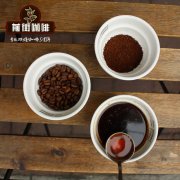How to make coffee beans sweet? can Katim's fishy smell be reduced during the baking stage?

Sweetness is one of the most popular characteristics of a good cup of coffee. In fact, almost all roasting and brewing techniques are also in pursuit of sweetness, whether you like light roasted coffee with bright and sour quality, or medium-and deep-roasted coffee with rich taste, the development and emphasis on sweetness is the key to forming a cup of pleasant and well-balanced coffee.
And this is also examined by decaf. Although it takes some adjustment to bake a sweet decaf, nothing can stop the sweetness of decaf.
Let's take a look at some of the factors that affect the sweetness of coffee, explore some practical roasting techniques to enhance sweetness, and examine the changes that need to be made when roasting decaf.
What is sweetness?
When it comes to the sweet aroma of coffee, we often think of the browning aroma of sugars, such as roasted nuts, caramel, chocolate, etc., but what causes these flavors?
The proteins and carbohydrates in raw coffee beans break down into caramel and amino acid complexes during baking, which are the reasons for the sweetness of coffee.
In particular, carbohydrates in coffee account for more than 1/3 of the soluble compounds, which contribute to the formation of coffee flavor, which is why sweetness can be found in various baking recipes. Although there is little bitterness in the shallow roasting and no sour in the deep roasting, the coffee with both roasting degrees will be sweet to some extent.
However, not as long as it is sweet, the human tongue can detect five basic tastes: sweet, sour, bitter and salty, none of which exist independently; on the contrary, they are adjusted in different proportions in different arrangements and combinations. If drinking a cup of coffee has only a sweet taste, but no sour support, it will form a dull cup of coffee that is defined as roasted.
In addition, in some combinations, the presence of one sense of taste can actually increase the perception of another. for example, salt or acid can increase the perception of sweetness.
So don't just focus on developing the maximum sweetness of coffee (converting most carbohydrates into caramel), but on developing other flavors and flavors that already exist so that sweetness complements it.
How to bake sweetness?
What is the most important element to bake the sweetness of coffee? The author found several experienced and knowledgeable European bean bakers, and they all agreed on three things: the selection of raw beans, the stage of development before the explosion, and the stage of development after the explosion.
Selection of raw beans
At the beginning, of course, we should choose raw beans with good quality and flavor characteristics, and of course, raw beans with better quality have more potential to develop sweetness. Dimitri Grodwohl, a bean baker at Oven Heaven, said: "if the quality of beans is not over there, you can't magically create sweetness by baking." "
Another important consideration is the sour quality of beans. As mentioned earlier in the article, the presentation of sweetness and acidity is the result of mixing and regulating each other in various ways. However, if you are dealing with extremely bright or strong acidity, you need to bake sweetness to find a better balance.
In the third wave of coffee, sometimes the sweetness of coffee is ignored in order to pursue the lively acidity. However, for bakers interested in exploring complex sweetness combinations, baking sweetness may be an ideal choice.
Ignasi Oller, manager of raw bean import at Cafe é s Pont in Spain, said that when roasting sweet coffee, he would avoid raw beans more than 1800 meters above sea level and prefer raw beans more than 800 to 1300 meters above sea level, such as Minas Brazil.
Coffee with an emphasis on sweetness shows more sweetness than roasted nuts, caramel and chocolate, with spices such as nut cream, sugar, dark chocolate, cocoa, and cloves. These flavor descriptions are memorable in themselves. More importantly, their corresponding flavors can often satisfy a variety of drinkers.
The stage of development before the first explosion Pre-Crack Development
When it comes to roasting coffee, the key is to find a balance between sweet, sour and bitter. The chemical reaction begins at the end of the dehydration stage, when the coffee begins to turn yellow, indicating that caramelization and Maynard reactions have begun. This stage is important for converting substances in raw beans into compounds that react with sweetness.
In SCA's article, Rob Hoos wrote: "the Maynard reaction affects the weight of coffee, which in turn affects the alcohol thickness of coffee, as well as the complexity of coffee flavor (imagine roasted aromas, spices, nuts / cocoa). "
There are two points to note here: the development of sugar browning associated with sweetness and mellow thickness adds to the sweetness of coffee. Think about which is more attractive to you, "milk chocolate" or "cream milk chocolate"? )
Therefore, between the beginning of the yellowing stage and the first explosion, sufficient development time is very important for caramelization. In addition, spending more time here will lead to the complexity of the flavor after sugar browning, as well as the fuller taste of coffee, which will also help to improve the sweetness.
At the same time, if this stage is too long, it may wear away the bright acidity of the coffee, so that the low acidity can not set off the sweetness of the coffee. Mike Strumpf, director of the Swiss caffeine company, warned: "to create a good flavor balance and emphasize sweetness, there is no need for over-caramelization. "
The stage of development after the first explosion Post-Crack Development
After an explosion, several chemical reactions take place very quickly. The organic acids that still exist at this stage will soon burn out and begin to taste bitter. If you want to pursue a sweet and sour balanced coffee, your goal is to wear off some of the acidity through this stage of development, but do not let the acidity become too low.
Dimitri said: "it is really necessary to degrade some compounds during baking, which give the coffee a grassy taste and a dry taste, allowing the natural sweetness to show. If baked for a long time after the first explosion, the smell of grass may be replaced by the bitterness of charred sugar. "
Before the second explosion, almost all acids are worn off by the baking process, while sweetness and bitterness are the main flavors. For Ignasi, his personal preference for the sweetest coffee is those that have been roasted to the second explosion or even about half a minute after the second explosion.
How long the baking should last depends on the acceptance of the coffee and the market. However, if done correctly, longer baking can produce richer and more complex sweetness. The key is to add beans before the coffee is too deep, burnt or smoky.
How to adjust the technique if you want to bake decaf?
What if the sweet coffee is decaf? Mike explained that the decaf process involves adding water to raw coffee beans to extract caffeine and then drying it again. He stressed that his company's decaffeinated process will be carried out as gently and carefully as possible, removing caffeine without affecting its flavor as much as possible. But eventually the cellular structure of the coffee has changed, so it needs to be roasted in different ways.
This means that the pre-explosion baking process needs to be done in a milder way. "decaffeinated coffee will follow a similar temperature curve during roasting, but the heating rate will be a little different because decaffeinated coffee is also treated," Mike said. So coffee beans retain calories to different degrees. "
Dimitri agreed and said it might be necessary to adjust the amount of beans roasted and the boiler preheating time for decaf. "We usually use a milder baking curve than usual to bake decaf coffee, such as a lower and slower heating rate, and then slow down the curve until the roasting is finished," he added.
The founder and CEO Fran Bernal of caf é Lab in Spain said: "there are two keys to maximize sweetness in the roasting of decaf coffee: extending the time and lowering the temperature. The goal is to slightly caramel before the first explosion. "
Mike said that when roasted for the first time, decaf reacts very differently from regular coffee. Once decaf starts to heat up, its development is different, and the amount of energy maintained in coffee beans is not very tight. The special cellular characteristics of decaf may pose a challenge to bean bakers. On the one hand, beans are easy to overbake and overdevelop; on the other hand, because they can't maintain the same amount of calories in beans, you can't just roast beans like ordinary coffee and wait for them to cool down. "
Mike compared samples of decaf roasted to the first explosion. "you have to keep heating but not too much," he stressed.
What about the bean baker? Fran chose a shorter-than-average development time, dropping the beans about 30 seconds after the first explosion. He also said that one of his colleagues further slowed down her baking before entering the first explosion, resulting in slower and more manageable momentum.
The development of roasting techniques depends on the coffee beans and bean roasters used. But few attributes are as popular as sweetness, and the good news is that this can be achieved in most coffees, including decaf.
Therefore, look for high-quality raw beans. Ensure that the first explosion has sufficient but not excessive caramelization, and skillfully control the baked beans after the first explosion to achieve the correct balance of sweetness, sour and bitterness. To make delicious and sweet coffee, you still need to keep baking to accumulate experience.
Important Notice :
前街咖啡 FrontStreet Coffee has moved to new addredd:
FrontStreet Coffee Address: 315,Donghua East Road,GuangZhou
Tel:020 38364473
- Prev

What are the health benefits of drinking organic coffee? what disadvantages of organic coffee need to be overcome?
People's views on organic coffee are very polarized. for those in favor of organic coffee, organic production is more helpful to the environment, while for those who are against organic, it may be mentioned that organic planting is inefficient and the certification process is expensive. and chemical residues can be burned during baking. Compared with non-organic coffee, organic coffee may be more labor-intensive and more expensive to produce.
- Next

What is the role of coffee flavor wheel description to teach you how to understand coffee flavor wheel
In order to officially start the experiment, we have made some basic preparations. At Kansas State University, five sensory scientists spent 150 hours analyzing 105 coffee samples from 14 countries. In order to avoid the interference of the difficult description of the cup flavor, these flavors will be matched to the specific taste perception. For example, a BlackBerry will not be described as a berry growing on the mountain walls of Argentina.
Related
- Beginners will see the "Coffee pull flower" guide!
- What is the difference between ice blog purified milk and ordinary milk coffee?
- Why is the Philippines the largest producer of crops in Liberia?
- For coffee extraction, should the fine powder be retained?
- How does extracted espresso fill pressed powder? How much strength does it take to press the powder?
- How to make jasmine cold extract coffee? Is the jasmine + latte good?
- Will this little toy really make the coffee taste better? How does Lily Drip affect coffee extraction?
- Will the action of slapping the filter cup also affect coffee extraction?
- What's the difference between powder-to-water ratio and powder-to-liquid ratio?
- What is the Ethiopian local species? What does it have to do with Heirloom native species?

